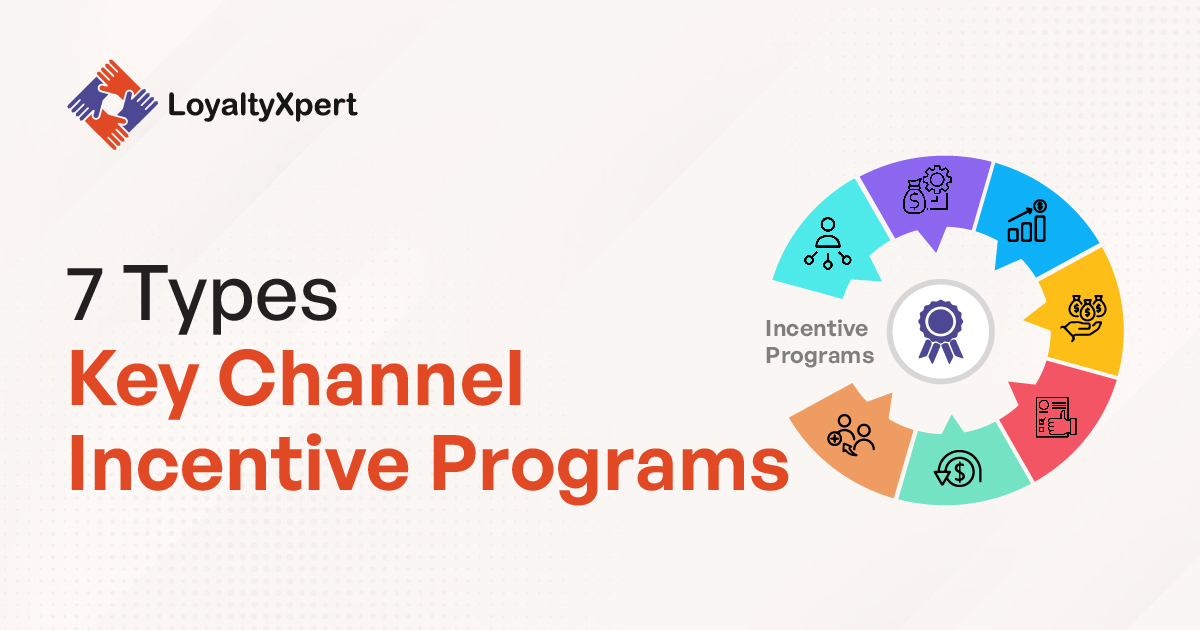CONTENT
“Variety is the spice of life.” This age-old adage is perfectly relevant for manufacturers and B2B companies who are using or planning to leverage channel incentive programs. When it comes to selecting the right programs for their channel sales partners and keeping them motivated and loyal in the long run, the options are plentiful indeed.
Unsurprisingly, a majority of successful B2B companies are increasingly using multiple types of channel incentive programs for different channel partners. An Accenture study found that more than two-thirds of channel partners who took part in the study said that they have more choices of channel incentive programs than ever before.
At LoyaltyXpert, we have designed channel pad a wide range of channel loyalty programs for all types and sizes of B2B companies in various industries. Apart from that, we also have crafted brand loyalty and influencer loyalty programs for them. In this blog post, we have listed seven key types of channel reward programs as well as discussed their benefits and challenges. Read on to know more.
1. Value-added reseller incentives
Value-added reseller incentives are the rewards channel partners receive when they add some additional value to enhance an existing product or service. The value addition can be in the form of an extra feature, integration, or product.
Benefits:
- Handle complex IT projects
- Increase market reach
A study by marketing insights firm Ariyh found that value-added reseller incentives can enhance a company’s overall sales by between six and nine%. The main advantages of value-added reseller incentives are they can enhance the value of an existing product as well as increase a brand’s market penetration. However, the biggest challenges of these types of incentives are they are extremely opaque.
Example
An electrical equipment distributor can qualify for value-added reseller incentives if they add some extra value (such as a special warranty) to an electrical product. Likewise, a paint dealer can get the incentive if they do the same with a paint product and sell it with additional offerings.
2. Market development funds
These educational or monetary incentives are used to enhance local brand awareness and recognition. Manufacturers provide these incentives to their channel partners to generate brand awareness and sell certain products.
Benefits
- Leverage partner market knowledge and power
- Generate a measurable return
For instance, channel sales partners can use market development funds to organize a marketing seminar, conduct webinars, purchase radio advertisements, or exhibit space at trade shows.
Example
The biggest merits of market development funds are that by using them, B2B companies can leverage the influence and market knowledge of their channel partners as well as generate a quantifiable return on their investment. This channel incentive program faces some major challenges such as the offers lasting for only a few days or weeks and the terms and conditions being a bit too strict.
“As per one recent research, market development funds account for nearly half of channel marketing budgets, but just a quarter of B2B firms report that their incentives achieve the desired objectives.”
3. Sales performance incentive funds
These are performance-driven incentives that the sales team of a channel partner receives after meeting particular goals such as selling specific products. Sales performance incentive funds are extremely useful in increasing sales and driving short-term spurts during sales slowdowns or off-season.
Benefits
- Increases sales momentum
- Counter competitors
- Helps target key individuals
The advantages of sales performance incentive funds are businesses can enhance their channel partners’ sales momentum, give strong competition to their competitors, and transfer the benefits to key members in their channel partner community. On the flip side, SPIFs are reactive and the incentives aren’t clear enough for channel partners’ sales teams.
Suggested Read: Why Channel Partner Loyalty Program Is Needed For Your Business
4. Cooperative incentives
Also called CO-OP funding, cooperative incentives enable businesses to help channel partners achieve their marketing objectives. Previously, these incentives were distributed as account credits. But now they have become an integral part of channel loyalty programs. These incentives reward channel partners for their continued loyalty and sustained purchases.
Benefits
- Opens doors to new ways of marketing
- More money, more ads
The most attractive benefits of CO-OP incentives are they enable B2B brands to have a local presence, which they won’t have otherwise, and they open new avenues for marketing. On the downside, however, cooperate incentives aren’t feasible for smaller B2B firms and they put an additional burden on a company’s marketing and sales team.
5. Deal registration incentives
These incentives are run by vendors who provide channel sales partners with extra incentives if they manage to bring in new leads to the vendors. These are one of the most effective and useful incentive programs in channel partner marketing as they enable vendors to reward their channel partners who play a huge role in enhancing their market share.
Benefits
- Enhanced efficiency
- Increased partner satisfaction
Some of the advantages of the incentives are increased efficiency and enhanced channel partner satisfaction. One of the biggest challenges for this incentive is that the transaction complexity is huge and there are inconsistencies in complying with registration regulations.
6. Channel rebates incentives
These are volume-based incentives that are designed to motivate your channel partners to sell a specific volume of products that would enable them to earn their incentive and transfer the benefits to their customers. In channel rebate incentives, a channel sales partner must sell a specific volume of products to get the right incentives.
- Retention rebate
- Mix rebate
- Volume rebate
- Growth rebate
The advantages of channel rebate incentives are they motivate channel sales partners to sell more of your products and build a strong customer base. The main challenges of channel rebate incentives are that they are a bit too complex and they require huge efforts and investment for proper implementation.
7. Channel referral incentives
Some channel partners have much stronger referral networks than their peers and this makes channel referral incentives one of the most preferable incentives for such channel partners. Some forms of referral incentives are debit cards, gift cards, incentive travel programs, and points-based awards.
Some merits of channel referral incentives are justifying the investment in rewarding channel partners is fairly simple and the results are visible. The challenges are the costs associated with these incentives are rather huge and the approach is quite new.
Taking everything into consideration
Previously, most B2B companies used to rely on just a few numbers of channel incentive programs to attract their channel sales partners and retain their loyalty. But with the advent of several new types of channel loyalty programs, businesses started leveraging multiple programs to remain ahead of the competition.
At LoyaltyXpert, we have equipped many manufacturing and B2B businesses with effective channel loyalty programs. If you are looking to use the most effective loyalty programs for your business, give us a call to know how we can help.
See how a smart loyalty program can boost your sales.
Get a free demo and discover how to drive loyalty with ease.
FAQs
Maulik Shah
Our CEO and co-founder, brings a wealth of IT experience to LoyaltyXpert. He has been the driving force behind LoyaltyXpert’s success and has led with a top-notch mix of technology and innovation that matches market expectations. Maulik employs technology to solve real-world challenges and integrates it into sales and marketing.




